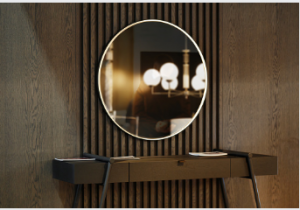Mirrors can be made from several materials, but glass and aluminium are the most common. Chrome, silver, and other metals have also been used. Plastic substrates are also a common choice for base materials. In this article, we’ll discuss how these elements can contribute to the overall look of a mirror.
Materials used to make a mirror.
 Mirrors are made of a variety of materials. Silica is the main component in sand, granite, and clay. The second component is feldspar, which contains calcium, sodium, and potassium. These minerals come from nature, but they can also be synthesized. The third material is silver. This metal is deposited onto glass through a chemical reaction.
Mirrors are made of a variety of materials. Silica is the main component in sand, granite, and clay. The second component is feldspar, which contains calcium, sodium, and potassium. These minerals come from nature, but they can also be synthesized. The third material is silver. This metal is deposited onto glass through a chemical reaction.
A majority of mirrors SA are made of glass. While glass is not an ideal reflector, it has several desirable properties. It’s transparent and malleable and has a high-quality surface when polished. Glass also can resist temperature changes, which is why mirrors made of glass are so durable. For information, learn here http://www.unleyglass.com.au/adelaide/glazing/main/mirrors-adelaide-unley-glass-adelaide/.
Curves
Curves in mirrors are reflections of the light that enters the mirror. Therefore, they can produce a variety of effects depending on their design. For example, a concave mirror can focus a wide beam. On the other hand, a parabolic mirror is shaped so that each ray of light that passes through it is focused on a single point. This shape is helpful in many applications, including solar cookers and car headlights.
Curves in mirrors also affect the appearance of an image. A concave mirror has a centre farther from the edges, which converges light rays into its focus. A concave mirror is often called a converging mirror. The focal length is the distance between the focal point and the centre of curvature of the mirror, and the focal length will determine the kind of image that it produces.
Surface regularity
The surface regularity of mirrors affects their reflection properties. For example, a mirror’s image will appear on the same side of the reflected object. But light must pass through the mirror’s actual image location to produce the reflection. Therefore, it makes it essential to maintain the surface regularity of mirrors. For information, learn here http://www.unleyglass.com.au/adelaide/glazing/main/mirrors-adelaide-unley-glass-adelaide/.
One way to measure surface regularity is by comparing the reference and test surfaces. It is often referred to as power. However, this measurement is not very sensitive to minimal irregularities. Hence, it’s usually expressed as a ratio of 5:1 power. If the difference is slight, it’s hard to detect.
Mirrors can have many different properties. Some are rougher than others, which reduces the reflection’s brightness. Those with high gloss or a high-gloss finish will reflect light better than those with low gloss.
Reflectivity
The reflectivity of mirrors is a crucial characteristic of optical devices. It is the percentage of optical power reflected by a mirror. This property depends on the wavelength, incidence angle and light’s polarisation direction. For example, a mirror that is opaque will have low reflectivity.
The wavelength at which a dielectric mirror will reflect light is the primary determinant of its reflectance. Other essential factors are the angle of incidence and specific properties of the dielectric coating. For example, a dielectric coating can have a very narrow bandwidth, while a mirror with a higher bandwidth will have a higher reflectance.
It is possible to determine the reflectivity of a mirror using a spectrophotometer. However, the sensitivity of this method is limited to reflectivities below 99.5%. It is because it reaches the signal-to-noise ratio limit if its reflectivity is higher.
Dielectric coating
Dielectric coatings are applied to mirrors to prevent them from scratching and deterioration. Metal mirrors typically have a metallic coating and a dielectric layer deposited over the metal. The result is increased durability. This type of coating is often referred to as protected metal films. There are also multiple-layer coatings available to improve reflectivity and modify performance. They can be coated in various ways and are designed based on the angle of incidence and the material of the substrate.
Another type of dielectric coating is made from polymers. These are transparent optical materials that can change the reflectivity of a substrate. They are often made using plasma-based film deposition or electron beam deposition. These layers offer a higher degree of control than single metallic coatings. They can be designed to have different reflective properties in different wavelength ranges.